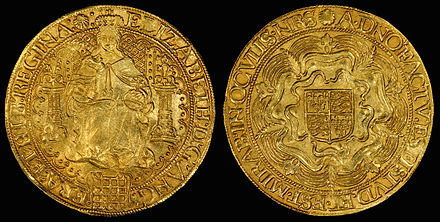The sovereign was a gold coin of the Kingdom of England first issued in 1489 under King Henry VII. The coin had a nominal value of one pound sterling, or twenty shillings. The sovereign was primarily an official piece of bullion and had no mark of value on its face. Nonetheless, it was the country's first coin to be valued at one pound.[1]
The name derives from the large size and majestic portrait of the monarch (the "sovereign"), with the obverse of the first sovereigns showing the king's full face, sitting on a throne, while the reverse shows the Royal Arms of England and a Tudor double rose.
The first sovereigns were of 23-carat (95.83%) gold and weighed 240 grains, or half a troy ounce. King Henry VIII lessened the gold content to 22 carats, or 91.67%. Although this was part of what is called The Great Debasement, 22 carats became the gold coin standard in both the British Isles and later the United States, known as crown gold.
It had a diameter of 42 millimetres (1.7 in), and weighed 15.55 grams (0.500 oz t), twice the weight of the existing gold coin, the ryal. The new coin was struck in response to a large influx of gold into Europe from West Africa in the 1480s, and Henry at first called it the double ryal, but soon changed the name to sovereign.[2] Too great in value to have any practical use in circulation, the original sovereign probably served as a presentation piece to be given to dignitaries.[3][Note 1] A double sovereign in the form of a piedfort was occasionally created for such purposes too.[4]
The inscription reads A DNO' FACTU' EST ISTUD ET EST MIRAB' IN OCULIS NRS - abbreviation for A DOMINO FACTUM EST ISTUD ET EST MIRABILE IN OCULIS NOSTRIS (Latin for "This is the Lord's doing and it is marvellous in our eyes", from Psalm 118).
- ^ Clancy 2017, p. 13.
- ^ Celtel & Gullbekk 2006, p. 61.
- ^ "Tudor sovereign". The Royal Mint Museum. Retrieved 17 Feb 2021.
- ^ Royal Mint Piedforts
Cite error: There are <ref group=Note> tags on this page, but the references will not show without a {{reflist|group=Note}} template (see the help page).
